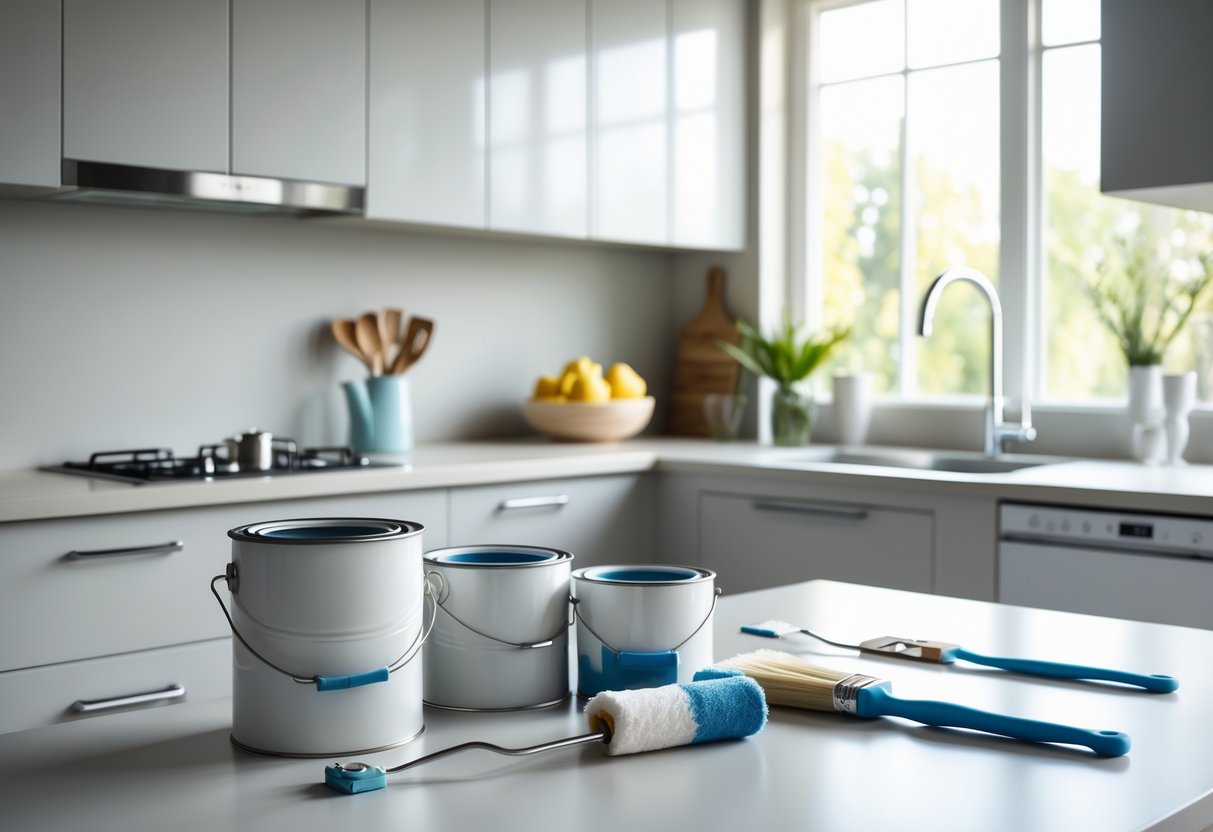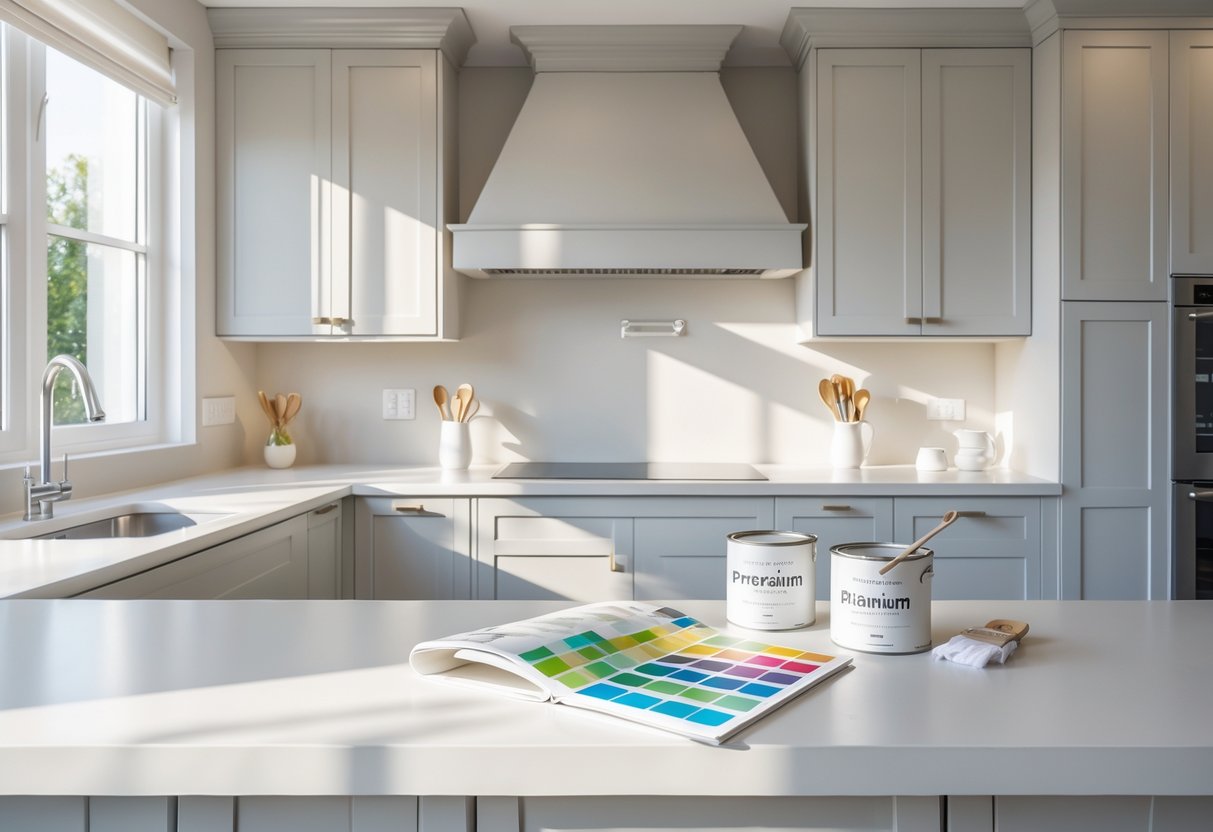Painting kitchen cabinets can completely change the look of a space without the cost of a full remodel. Choosing the right paint makes the difference between a smooth, durable finish and one that chips or fades too quickly. The best paint for kitchen cabinets is a high-quality acrylic or alkyd enamel that provides strong coverage and a hard, long-lasting surface.
Many people struggle with deciding between oil-based and water-based paints. Today’s advanced formulas offer the durability of oil with the easy cleanup of water-based options, making them a practical choice for busy kitchens. With the right paint, cabinets can handle daily use while still looking fresh.
The right preparation and product ensure cabinets not only look good on day one but also stay that way over time. Knowing which paints perform best helps avoid wasted effort and ensures a professional-looking result.
Key Takeaways
- The right paint type creates a durable and smooth cabinet finish
- Choosing quality products prevents chipping and fading
- Proper steps make cabinets look professional and last longer
Choosing the Best Paint for Kitchen Cabinets
The right paint for kitchen cabinets should last through daily use, resist stains, and clean easily. It also needs to match the desired finish, whether smooth and glossy or soft and matte.
Key Factors: Durability, Cleanability, and Application
Durability matters because kitchen cabinets face constant handling, grease, and moisture. A strong cabinet paint resists chipping and peeling, keeping surfaces looking new longer. Oil-based paint is known for toughness, while newer water-based and hybrid paints also provide lasting strength.
Cleanability is another key factor. Cabinets often collect fingerprints, food splatters, and dust. A paint with a smooth, non-porous surface allows quick wipe-downs without scrubbing. Semi-gloss and satin finishes usually offer the best balance of easy cleaning and subtle shine.
Application affects both the process and the final look. Latex paint dries quickly and has low odor, making it easier to work with indoors. Oil-based paint levels well and leaves a smooth finish but requires longer drying time and stronger ventilation. Hybrid and acrylic paints combine smoother application with easier cleanup.
Types of Cabinet Paint: Oil-Based, Latex, Hybrid, and Acrylic
Oil-based paint creates a hard, durable surface that resists scratches, but it has high VOC content and requires mineral spirits for cleanup. It also takes longer to dry, which can slow down projects.
Latex paint, a water-based option, offers faster drying, lower odor, and easier cleanup with soap and water. It is less prone to yellowing over time but may not be as durable as oil-based.
Hybrid paint, often called waterborne alkyd, combines the durability of oil-based with the easy cleanup of latex. It provides a smooth, strong finish with lower VOC levels than traditional oil-based paint.
Acrylic paint is a premium water-based choice that resists cracking and fading. It adheres well to wood and laminate surfaces, making it versatile for different cabinet materials.
| Paint Type | Durability | VOC Content | Cleanup Method | Dry Time |
|---|---|---|---|---|
| Oil-Based | High | High | Mineral spirits | Slow |
| Latex | Moderate | Low | Soap and water | Fast |
| Hybrid/Alkyd | High | Moderate | Soap and water | Moderate |
| Acrylic | High | Low | Soap and water | Fast |
Popular Paint Finishes: Satin, Semi-Gloss, Matte, and High-Gloss
A satin finish offers a soft sheen that hides minor flaws while still being easy to clean. It works well for kitchens where a subtle look is preferred.
A semi-gloss finish reflects more light and is one of the most common choices for kitchen cabinets. It balances durability with ease of cleaning, making it practical for busy households.
A matte finish gives a smooth, flat look but shows marks and stains more easily. It is less common for cabinets since it requires more upkeep.
A high-gloss finish creates a reflective surface that looks sleek and modern. While very durable and easy to wipe clean, it highlights imperfections in the cabinet surface.
Finish Comparison:
- Satin: Subtle shine, hides flaws, easy to clean
- Semi-Gloss: Durable, versatile, easy to wipe
- Matte: Smooth look, harder to maintain
- High-Gloss: Sleek, easy to clean, shows imperfections
Top Recommended Paints and Essential Painting Tips

Choosing the right paint, applying it correctly, and protecting the finish all play a major role in how long kitchen cabinets will look good and hold up to daily use. Each step matters, from brand selection to surface prep to adding a durable topcoat.
Best Paint Brands for Kitchen Cabinets
Several paints stand out for cabinet projects because they combine durability with a smooth finish. Benjamin Moore Advance is a popular choice since it uses a waterborne alkyd formula. This gives the look of oil-based paint but with easier cleanup and less odor. It levels well, which helps reduce visible brush marks.
Sherwin-Williams Emerald Urethane Trim Enamel is another strong option. It resists yellowing, dries hard, and works well on high-traffic surfaces. Many homeowners prefer it for its balance of toughness and attractive finish.
For a budget-friendly option, INSL-X Cabinet Coat provides reliable adhesion and a satin finish. It bonds to wood, laminate, and even metal without the need for a primer in some cases.
When comparing paints, it helps to look at drying time, sheen options, and how well the product resists chipping. A simple table can help:
| Paint Brand | Key Feature | Finish Type | Best Use |
|---|---|---|---|
| Benjamin Moore Advance | Waterborne alkyd, smooth leveling | Satin/Semi-Gloss | Professional look, durable |
| Sherwin-Williams Emerald Urethane | Hard finish, stain resistant | Satin/Semi-Gloss | Heavy-use kitchens |
| INSL-X Cabinet Coat | Strong adhesion, budget option | Satin | Quick cabinet makeover |
Preparation and Application Methods
Good results depend on how well the surface is prepared before painting. Homeowners should remove doors and hardware, clean all surfaces with a degreaser, and sand lightly to create a smooth base. Filling gaps or dents with wood filler ensures an even finish.
Priming is often necessary, especially on bare wood or glossy surfaces. A bonding primer helps paint stick better and prevents stains from showing through.
For application, both brushing and rolling can work, but many prefer a sprayer for the smoothest coat. If using a brush, a high-quality angled brush leaves fewer streaks. Foam rollers also help reduce texture.
Thin coats are better than thick ones. Applying two or three light coats gives a stronger, more even finish. Allowing proper drying time between coats prevents peeling or tackiness.
Protective Topcoats and Long-Term Cabinet Care
Even the best paint for kitchen cabinets benefits from an added layer of protection. A protective topcoat such as a clear polyurethane or water-based polycrylic helps guard against scratches, grease, and moisture. Water-based formulas are preferred since they resist yellowing and keep the paint color true.
Topcoats should be applied in thin, even layers. A satin or semi-gloss finish works well in kitchens because it balances durability with easy cleaning. Avoid high-gloss unless a very shiny look is desired, as it can highlight imperfections.
For long-term care, cabinets should be wiped with a damp cloth instead of harsh cleaners. Checking for chips or worn areas and touching up early prevents larger problems. With proper prep, the right paint, and a strong topcoat, a cabinet makeover can last for many years.
Interesting Read: How to Whiten a Deer Skull to Treasure It for a Long Time?
Frequently Asked Questions

Durability, finish, number of coats, and surface preparation all affect how well paint performs on kitchen cabinets. The right choices help the cabinets resist wear, stay easy to clean, and maintain a smooth appearance.
What type of paint ensures the highest durability for kitchen cabinets?
Acrylic enamel and alkyd-based paints provide the strongest durability. These paints form a hard surface that resists chipping and scratching. They also hold up well against moisture and frequent cleaning.
What finish options are recommended for a long-lasting and easy-to-clean kitchen cabinet surface?
Semi-gloss and satin finishes are most often recommended. Both finishes create a smooth surface that wipes clean without much effort. Semi-gloss offers more shine and durability, while satin gives a softer look with slightly less reflection.
How many coats of paint are typically needed to fully cover kitchen cabinets?
Two coats of paint usually provide full coverage. A primer coat is often applied first to improve adhesion and block stains. In some cases, a third coat may be needed for darker colors or uneven surfaces.
Can I apply a new layer of paint over old paint on kitchen cabinets?
Yes, but the surface must be prepared first. Sanding the old finish and cleaning off grease or residue helps the new paint bond properly. Applying a primer before painting ensures a smoother and longer-lasting result.

